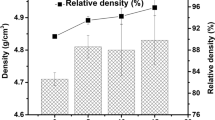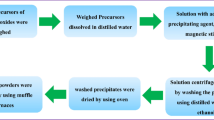The preparation and mechanical properties of composites with 20 mol.% Al2O3 and 80% [3Yb–TZP] modified with strontium oxide are considered. It is shown that during heat treatment of the initial nanopowders the strontium hexaaluminate phase is formed in situ. Acorrelation was established between an increase in the concentration of the modifier and an increase in the volume fraction of the strontium hexaaluminate phase. It was revealed that modifier content above 3% brings about an increase in the porosity of the composites. It was determined that composites modified with 1 – 2 mol.% SrO have bending strength 850 MPa and crack resistance K1c up to 11.3 MPa ∙ m1/2.





Similar content being viewed by others
Notes
Here and below, the molar content, %.
References
V. S. Bakunov, A. V. Belyakov, E. S. Lukin, and U. Sh. Shayakhmetov, Oxide Ceramic: Sintering and Creep [in Russian], RKhTU im. D. I. Mendeleeva, Moscow (2007).
J. Chevalier, P. Taddei, L. Gremillard, et al., “Reliability assessment in advanced nanocomposite materials for orthopedic applications,” J. Mat. Behavior Biomedical Mat., 4(9I.3), 303 – 314 (2011); URL: 10.1016/j.jmbbm.2010.10.010.
L. V. Morozova, M. V. Kalinina, M. Yu. Arsent’ev, and O. A. Shilova, “Influence of cryochemical and ultrasonic treatment on texture, thermal decomposition of xerogels, and properties of nanoceramics in the ZrO2 ∙ Y2O3 ∙ Al2O3 system,” Inorg. Mater., 53(6), 654 – 661 (2017); DOI https://doi.org/10.7868/S0002337X17060112.
J. Chevalier, A. Liens, H. Revero, et al., “Fourty years after the promise of ‘ceramic steel?’: Zirconia-based composites with a metal-like mechanical behavior,” Am. Ceram. Soc., 103(3), 1482 – 1533 (2019).
S. J. Lee, S. Y. Chun, and C. H. Lee, “In situ fabrication of multi-component ceramic composites by steric organic entrapment route,” J. Mater. Lett., 58, 2646 – 2649 (2004); https://doi.org/10.1016/j.matlet.2004.03.036.
E. A. Lyapunova, M. V. Grigoriev, A. P. Skachkov, et al., “Composite based on zirconium dioxide modified with carbon nanotubes: structure and mechanical properties,” Vest. Perm. NIPU, Mekhanika, No. 4, 308 – 316 (2015); DOI 10.15593/perm.mech/2015.4.18.
H.-J. Kleebe, G. Pezzotti, and G. Ziegler, “Microstructure and fracture toughness of Si3N4 ceramics: Combined roles of grain morphology and secondary phase chemistry,” J. Am. Ceram. Soc., 82(7), 1857 – 1867 (1999); 10.1111/j.1151-2916.1999.tb02009.x.
N. Belousova, S. Veselov, N. Cherkasova, et al., “Techniques of SrAl12O19 platelets formation in ZTA,” Appl. Mechan. Mater., 788, 246 – 251 (2015).
L. I. Podzorova, A. A. Il’icheva, O. I. Pen’kova, et al., “Disperse hardening of composites in the system aluminum oxide and cerium cation stabilized tetragonal zirconium dioxide,” Glass Ceram., 74(5 – 6), 204 – 208 (2017) [Steklo Keram., No. 6, 16 – 20 (2017)]; DOI 10.1007_s10717-017-9962-8.
L. I. Podzorova, A. A. Il’icheva, V. E. Kutuzova, et al., “Composites with α-Al2O3 matrix, strengthened with calcium hexaaluminate-cerium,” Ogneup. Tekh. Keram., No. 4-5, 8 – 12 (2019).
S.M. Naga, M. Elshaer,M. Awaad, and A. A. Amer, “Strontium hexaaluminate ZTA composites: Preparation and characterization,” Mater. Chem. Phys., 232, 23 – 27 (2019); DOI https://doi.org/10.1016/j.matchemphys.2019.04.055.
F. Kern and R. Gadow, “Influence of in-situ platelet reinforcement on the properties of injection moulded alumina-toughened zirconia,” J. Ceram. Sci. Tech., 2(1), 47 – 54 (2011); DOI: 10.4416_JCST2010-00019.
N. Yu. Cherkasova, A. A. Bataev, S. V. Veselov, et al. “Structure and fracture toughness of ceramics based on Al2O3 and ZrO2 with the addition of SrAl12O19,” Pis’ma Mater., 9(2), 179 – 184 (2019); https://doi.org/10.22226/2410-3535-2019-2-179-184.
A. A. Il’icheva, L. I. Podzorova, V. P. Sirotinkin, et al., “Formation of strontium hexaaluminate in alumina–tetragonal zirconia systems modified with strontium cations,” Russ. J. Inorg. Chem., 65(2), 154 – 160 (2020); DOI https://doi.org/10.1134/S0036023620020060.
G. N. Shabanova, Ya. N. Pitak, V. V. Taranenkova, et al., Refractory Cements Based on Compositions of Multicomponent Zirconium-Containing Systems [in Russian], Izdatel’ S. G. Rozhko, Khar’kov (2016); ISBN 978-966-97496-1-1.
L. I. Mirkin, Handbook of X-Ray Structural Analysis of Polycrystals [in Russian], Fizmatlit, Moscow (1961).
V. M. Samsonov, S. S. Kharechkin, S. L. Gafner, et al., “Molecular-dynamic study of melting and crystallization of nanoparticles,” Kristallografiya, 54(3), 563 – 569 (2009).
Author information
Authors and Affiliations
Corresponding author
Additional information
Translated from Steklo i Keramika, No. 6, pp. 22 – 28, June, 2021.
Rights and permissions
About this article
Cite this article
Podzorova, L.I., Il’icheva, A.A., Sirotinkin, V.P. et al. Ceramic Composites of the Zirconium Dioxide and Aluminum Oxide System Including Strontium Hexaaluminate. Glass Ceram 78, 231–236 (2021). https://doi.org/10.1007/s10717-021-00385-x
Published:
Issue Date:
DOI: https://doi.org/10.1007/s10717-021-00385-x




